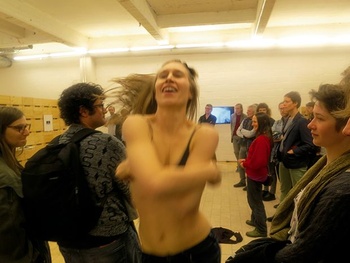(© Virginie Mira)
The Danish choreographer Mette Ingvartsen, associated artist of the Kaaitheater, has invented a hybrid form of theatrical performance that combines dance, performance, lecture, and exhibition. In the solo production 69 Positions, Ingvartsen uses this form to start exploring a whole new field of interest.
69 positions is a very commercial title, isn’t it?
Mette Ingvartsen: [Laughs] I don’t know if that is true. The title has a lot of meanings. I am working on a history of sexuality, or at least my own history of seeing and dealing with art performances, references, and phenomena that involve sexuality not as something intimate and private, but as something that is shaping our public and political sphere, and the way it functions. The title is not “Position 69”, but 69 Positions. I’m producing a kind of archive. In the performance I try to expose a multiple array of positions on sexuality and the nude body as a public tool, dating from the 1960s up until today. So the 69 obviously refers to the sexual position, but also to the 1960s. In the 1960s, the naked body was used, for instance, as a protest tool against the Vietnam War, whereas today sexuality seems to have moved into all the different layers of our society. Private and public spaces are merging, in part due to social media. But that does not mean that the private sphere no longer constructs our public and political environment.
Do you see other evolutions from what you have been studying and observing so far?
Ingvartsen: One of the reasons why people don’t change is that we forget what has already been done in the past. It is interesting therefore to see what the sexual revolution of the 1960s has actually led to. You might say that we are now in a post-pornographic society, but I’m not at all sure that the revolution has achieved its goals. Take issues like women’s liberation and equality for example, or the way specific types of family structures are still implicitly promoted by society. In some cases you could even say that we have returned to a pre-1960s situation. Another interesting subject is the access to explicit sexual imagery. These days, eleven-year-old boys are already watching pornography. Eight-year-old children perform sexually charged dances without knowing what those movements signify. So the image gets detached from the actual bodily practice of having sex to which it refers. That is fertile territory for a choreographer. In the solo I will be trying to crack and reverse some of these codes according to which bodies behave.
Do you still have time to visit other dance performances in the meantime?
Ingvartsen: I would like to recommend the festival of Les Brigitinnes. It started a while ago – incidentally, Anne Juren’s piece Magical also dealt with questions related to the 1960s – but it will run until 31 August in a very good atmosphere and setting (and with performances by Ayelen Parolin, Sabine Molenaar, and Compagnie Mossoux-Bonté).
69 POSITIONS
9 > 11/10, Kaaitheater, www.kaaitheater.be

Fijn dat je wil reageren. Wie reageert, gaat akkoord met onze huisregels. Hoe reageren via Disqus? Een woordje uitleg.